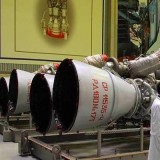Delair’s OSKAR Loitering Munition Combines Extended Range and Electronic Countermeasure Resistance at SOFINS 2025
{loadposition bannertop}
{loadposition sidebarpub}
Presents at the SOFINS 2025 exhibition, the OSKAR loitering munition, developed by Delair and KNDS France, represents a new generation of tactical remotely operated munitions designed to meet the requirements of special forces and forward-deployed units. While not being introduced for the first time, the system now stands out due to its technical maturity and its specific capabilities in terms of endurance, precision, and resilience in contested electromagnetic environments.
Follow Army Recognition on Google News at this link
A key strength of the OSKAR lies in its ability to operate effectively in environments subject to heavy electronic jamming or lacking satellite navigation services (Picture source: Army Recognition)
Built on the fixed-wing UX11 drone platform from Delair, the OSKAR system incorporates a 2.3 kg fragmentation warhead with controlled effects developed by KNDS France, the entity formerly known as Nexter Arrowtech. The project originated under the Colibri call for proposals launched in 2022 by France’s Direction Générale de l’Armement (DGA), which aimed to accelerate the fielding of low-cost, lightweight, hand-deployable loitering munitions. Initially planned with a range of approximately 8 km, OSKAR was quickly adapted to achieve an operational range of 25 km, with flight performance optimized for Beyond Visual Line of Sight (BVLOS) missions.
A key strength of the OSKAR lies in its ability to operate effectively in environments subject to heavy electronic jamming or lacking satellite navigation services (GNSS-denied). This capability is particularly relevant to special operations, enabling the drone to carry out accurate strikes even in highly contested electromagnetic conditions. Its rapid deployment, compact design, and minimal logistical footprint make it suitable for infiltration missions, offensive reconnaissance, or targeted neutralization at medium range.
KNDS France has integrated OSKAR into a broader family of remotely operated munitions called MATARIS, named after the Gallic javelin. Now designated MV-25, this model complements a product range that also includes the short-range MT-10 and MX-10 multicopter variants, as well as the future high-speed MV-100. These systems offer land forces a modular set of capabilities, from precision strikes within a 10 km radius to deeper engagements beyond 80 km, depending on the warhead and launch platform configuration.
The DGA has already placed orders for several hundred units across this munitions range, with production involving close cooperation between French SMEs such as Delair, EOS Technologie, and TRAAK. This approach reflects a strategic objective to develop a sovereign technological base in a rapidly evolving sector. Rather than building large inventories, the French Army emphasizes the need for a flexible and continuous production capacity to adjust quickly to changing threats and advances in opposing technologies.
Although primarily intended for French forces, the OSKAR drone has already seen operational deployment in Ukraine, where around one hundred units were delivered in 2024. These shipments, part of a broader order for 2,000 loitering munitions announced by the French Ministry of Armed Forces, allowed the system to be tested under high-intensity combat conditions, particularly in environments with extensive electronic warfare activity. The operational feedback from these deployments has helped validate the system’s performance and guide further development.
Delair and KNDS France are emerging as key contributors in this field of technological rearmament, offering systems that are already operational and scalable. OSKAR’s ease of use, resistance to countermeasures, and precision meet the specific requirements of special forces for discreet and responsive strike capabilities. As remotely operated munitions become a standard element on today’s battlefields, their integration into tactical units and broader military doctrines appears increasingly likely.

{loadposition bannertop}
{loadposition sidebarpub}
Presents at the SOFINS 2025 exhibition, the OSKAR loitering munition, developed by Delair and KNDS France, represents a new generation of tactical remotely operated munitions designed to meet the requirements of special forces and forward-deployed units. While not being introduced for the first time, the system now stands out due to its technical maturity and its specific capabilities in terms of endurance, precision, and resilience in contested electromagnetic environments.
A key strength of the OSKAR lies in its ability to operate effectively in environments subject to heavy electronic jamming or lacking satellite navigation services (Picture source: Army Recognition)
Built on the fixed-wing UX11 drone platform from Delair, the OSKAR system incorporates a 2.3 kg fragmentation warhead with controlled effects developed by KNDS France, the entity formerly known as Nexter Arrowtech. The project originated under the Colibri call for proposals launched in 2022 by France’s Direction Générale de l’Armement (DGA), which aimed to accelerate the fielding of low-cost, lightweight, hand-deployable loitering munitions. Initially planned with a range of approximately 8 km, OSKAR was quickly adapted to achieve an operational range of 25 km, with flight performance optimized for Beyond Visual Line of Sight (BVLOS) missions.
A key strength of the OSKAR lies in its ability to operate effectively in environments subject to heavy electronic jamming or lacking satellite navigation services (GNSS-denied). This capability is particularly relevant to special operations, enabling the drone to carry out accurate strikes even in highly contested electromagnetic conditions. Its rapid deployment, compact design, and minimal logistical footprint make it suitable for infiltration missions, offensive reconnaissance, or targeted neutralization at medium range.
KNDS France has integrated OSKAR into a broader family of remotely operated munitions called MATARIS, named after the Gallic javelin. Now designated MV-25, this model complements a product range that also includes the short-range MT-10 and MX-10 multicopter variants, as well as the future high-speed MV-100. These systems offer land forces a modular set of capabilities, from precision strikes within a 10 km radius to deeper engagements beyond 80 km, depending on the warhead and launch platform configuration.
The DGA has already placed orders for several hundred units across this munitions range, with production involving close cooperation between French SMEs such as Delair, EOS Technologie, and TRAAK. This approach reflects a strategic objective to develop a sovereign technological base in a rapidly evolving sector. Rather than building large inventories, the French Army emphasizes the need for a flexible and continuous production capacity to adjust quickly to changing threats and advances in opposing technologies.
Although primarily intended for French forces, the OSKAR drone has already seen operational deployment in Ukraine, where around one hundred units were delivered in 2024. These shipments, part of a broader order for 2,000 loitering munitions announced by the French Ministry of Armed Forces, allowed the system to be tested under high-intensity combat conditions, particularly in environments with extensive electronic warfare activity. The operational feedback from these deployments has helped validate the system’s performance and guide further development.
Delair and KNDS France are emerging as key contributors in this field of technological rearmament, offering systems that are already operational and scalable. OSKAR’s ease of use, resistance to countermeasures, and precision meet the specific requirements of special forces for discreet and responsive strike capabilities. As remotely operated munitions become a standard element on today’s battlefields, their integration into tactical units and broader military doctrines appears increasingly likely.






